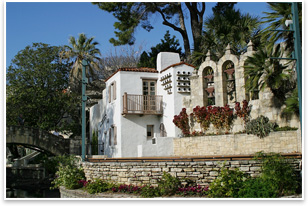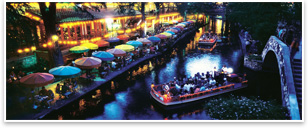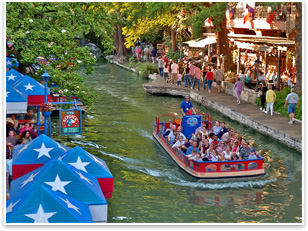
A Walk Through History—San Antonio’s River Walk
River ebbs and flows
A flood in 1921 restored the river, although with damaging results. A dam was built in 1926. Hugman, who was only starting out, had a plan called Romula, inspired by “the old cities of Spain,” the bending canals and water gardens of Xochimilco, south of Mexico City, and the twisting rockwork of the post-World War I Japanese Sunken Gardens. His plan, however, was blasted as an “idle dream.”
Crown jewel of Texas In all, the completed River Walk was 21 blocks or 8,500 feet of riverbank with 17,000 feet of sidewalks; 11,000 cubic yards of masonry; 31 stairways; 3 dams; 40,000 trees, shrubs, and plants; and a vast number of stone, cement, and cedar benches. The final cost was $442,900. Fifty thousand people lined the River Walk on April 21, 1941, for the dedication.
Preserve the River Walk |
||
Copyright 2007 The American Institute of Architects. All rights reserved. Home Page |
||
Did you know . . .
Harold L. Eiserloh, Emeritus AIA, San Antonio Chapter, offers fun and practical suggestions in his booklet, Things to Do, See & Photograph in and Around San Antonio:
• Early afternoon is always a good time to walk or boat ride the full length of the River Walk, including the spur to River Center Mall. You will see many photo opportunities such as stone arched bridges, reflections, brightly colored umbrellas, sidewalk restaurants, boats, plants, trees, and the many different buildings for backgrounds.
• Tall trees are on both sides of the river, almost forming a canopy in some places. Wear walking shoes—the walking surface is too rough for high heels. It is now wheelchair accessible by elevator and ramps.
• A boat ride will get you a one-hour overview of what is available on the River Walk.
• In the evening, sparkling lights illuminate the River Walk, reflecting off the water, creating a completely different atmosphere than during the day. On Thursday, Friday, and Saturday evenings (the same nights as the AIA National Convention this year) three- to five-member costumed Mariachi bands wander along the walk and into restaurants, serenading guests.
• La Villita (where the Host Chapter Party will be held on May 4) was restored and remodeled to provide a glimpse into past centuries. Many of the buildings are over 200 years old, with 26 small museums, craft shops (some with working artisans), galleries, boutiques, plazas, and restaurants.
During the AIA National Convention in San Antonio, May 3–5, the AIA and AIA San Antonio are offering professional tours of the River Walk, as well as sites in the city, for learning units. You can get information in the Convention 2007 Guide or at www.aiaconvention.com. Early sign-up is recommended. Registrants requiring wheelchair access or other special accommodations must contact the AIA, aia@laser-registration.com or 800-242-3837, no later than March 28. Special guest tours are also available.

 Summary:
Summary: What started as a tiny, writhing downtown stream has now become one of the top travel destinations in Texas, pumping $3 million per into year into San Antonio’s economy. In his book
What started as a tiny, writhing downtown stream has now become one of the top travel destinations in Texas, pumping $3 million per into year into San Antonio’s economy. In his book 
 Along the River Walk is La Villita, “The Little Village,” part of the original Mexican San Antonio. An attraction in La Villita is Arneson River Theater, an open-air venue erected in 1939 and designed by Hugman. The stage is on the north side of river and the audience sits on the grass-covered steps on the south side. Periodically, river taxis float by between audience and stage. It is located in the shadow of the Hilton Palacio Del Rio hotel.
Along the River Walk is La Villita, “The Little Village,” part of the original Mexican San Antonio. An attraction in La Villita is Arneson River Theater, an open-air venue erected in 1939 and designed by Hugman. The stage is on the north side of river and the audience sits on the grass-covered steps on the south side. Periodically, river taxis float by between audience and stage. It is located in the shadow of the Hilton Palacio Del Rio hotel.